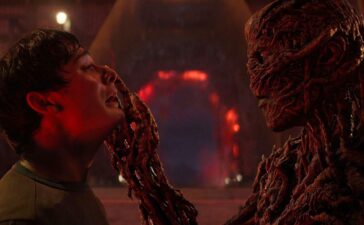Richard Stanley has not made a feature film since 1996, the year he was unceremoniously fired from the famously disastrous, Marlon Brando-starring The Island of Doctor Moreau mere weeks into shooting.
Although veteran director John Frankenheimer took over and was the credited director on the notorious flop, nonetheless the film seemed to mark the end of Stanley’s career.
This was a damn shame; the South African Stanley had emerged out of documentary and music videos (his clips for goth/western outfit Fields of the Nephilim may explain his love of hats) and had two idiosyncratic, attention-grabbing features under his belt – 1990’s cyberpunk thriller Hardware and 1992’s elliptical supernatural serial killer flick Dust Devil – when the wheels came off. His voice is distinctive and left-of-centre, steeped in goth and industrial subculture, drawing on real world folklore and anthropology.
He didn’t completely disappear, producing the odd short and documentary subject – 2001’s The Secret Glory, on SS Officer and grail seeker Otto Rahn is great – but unless you were a habitué of the more esoteric corners of the film world, he may as well have been.
Well, he’s certainly back with a vengeance now, though. Stanley’s new film, Color Out of Space, is a mind-bending sci-fi horror based on the eponymous story by revered weirdo H.P. Lovecraft – you know, the Cthulhu guy. And speaking of revered weirdoes, the film stars none other than Nicolas Cage as Alpaca farmer Nathan Gardner, whose New England farm becomes the epicenter of a plague of mutation and horror when a meteorite brings an otherworldly “colour” to earth. It’s a hell of film, a near-perfect midnight movie mash up of sublime strangeness, visceral gore, creeping unease and the odd patented Nic Cage freak out.
Those freak outs were carefully calibrated, Stanley tells us, recalling how the Wild At Heart icon sat down with the script and marked it up. “He went through and highlighted scenes where he could really let loose, like the tomato scene and the breakdown in the car,” tailoring his performance to the film.
Having Cage in the film was a godsend to Stanley, who had been ruminating on adapting Lovecraft’s 1927 story for years. “I first wrote the script years ago because I saw how it could be done on a low budget. Unlike other Lovecraft stories, The Color Out of Space is just set on a farm. You didn’t need to go to the bottom of the Marianas Trench or to Antarctica.” Cage had made a splash in horror circles with Panos Cosmatos’ psychedelic rock ‘n’ roll gorefest, Mandy, in 2018. Color Out of Space shares a production company, Elijah Woods’ genre specialist outfit Spectrevision, with Mandy, and it was through this avenue that a draft of Stanley’s script found its way into Cage’s hands.
“I got a call from a bar to my landline – my French landline – in the middle of the night,” Stanley tells us. “And it was Nic. I couldn’t quite believe it.” Nonetheless, it was Cage himself, who waxed enthusiastic about the project. With Cage on board, the long-germinating film came together remarkably quickly.
Depending on how you measure it, of course; Stanley, whose interests in the occult is a matter of record, recalls his mother, the late anthropologist Penny Miller, reading him Lovecraft’s tales of terror when he was only seven – so perhaps we should mark that as the initial seed of creativity?
Tragically and ironically, Stanley returned the favour when he was nursing her through terminal lymphoma. He tells us how watching not just her body but her mind mutate into something unrecognisable influenced the character of Theresa Gardner, Nathan’s wife, played by Joely Richardson. Already in recovery from breast cancer, she undergoes a horrible transformation under the Color’s influence, a direct echo of Miller’s final days. “She would snarl at me,” Stanley notes sadly. “When I told her we were doing the film she snapped, ‘Oh, it’ll all come to nothing.’
Which is, in fact, not an uncommon reaction to the possibility of filming Lovecraft whose works, filled with mind-obliterating creatures and vistas that send their hapless protagonists screaming into insanity, are often considered unfit for the screen. Acclaimed fantasist Guillermo del Toro tried and failed to mount a big budget version of At the Mountains of Madness with James Cameron producing and Tom Cruise in the lead, but the old stranger from Providence still has a cinematic footprint. Stanley praises Stuart Gordon’s Re-Animator films but laments that they never got Lovecraft’s sense of cosmic horror right, while averring that “…John Carpenter’s The Thing is the most Lovecraftian film that isn’t a Lovecraft adaptation.” Others might pick Carpenter’s own In the Mouth of Madness, currently celebrating it’s 25th anniversary.
For his part, Stanley is planning two more Lovecraft adaptations to round out a full trilogy of terror, with the next project being a version of The Dunwich Horror, the story of an inbred backwoods family, The Whateleys, who worship The Great Old Ones, Lovecraft’s pantheon of alien gods.
Stanley’s take on it? “The Whateley’s Arkham country is Trump’s America.”
But of course. We can’t wait.
Color Out Of Space is at cinemas now.
You can purchase tickets after the jump.










